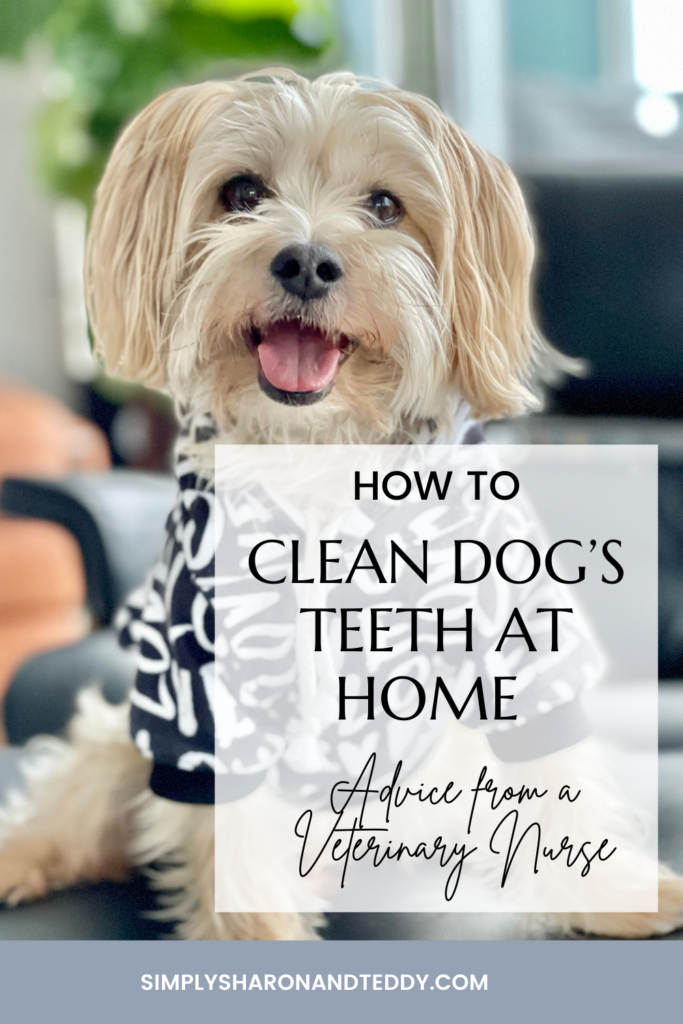
How To Clean Dog’s Teeth At Home: Advice From A Veterinary Nurse
Periodontal disease or gum disease in dogs is an important topic that all dog parents need to take seriously because almost 90% of dogs will develop some form of dental disease by 2 years of age. This is why I asked fellow dog mom and veterinary nurse, Karolina Szoda, how to clean my dog’s teeth at home. It was no surprise to me when she revealed that the most frequently asked questions she receives from dog owners is about dog dental care.
I had quite a few questions myself for Karolina about dog oral health. There are many products found at pet stores to help remove plaque from dog’s teeth including dental treats, dental chews and bones, dental wipes, dental sprays. The list goes on! As a veterinary nurse, Karolina shared her expertise on what products to invest in to keep my dog’s teeth clean at home. It’s important to me to learn how to clean my dog’s teeth in between his professional dental cleanings that are done under anesthesia at the veterinary office. Prevention is key when it comes to periodontitis in dogs.
Karolina Szoda, LVT is a veterinary nurse with over 16 years of experience working in general practice and at emergency hospitals. When she isn’t working as a veterinary nurse, she is a flight attendant and brings her dog @MinutewithMilo to work!
The original interview was part of my “Dog Mom Live Series” on my Instagram account. The series highlighted dog moms and their expertise in the dog world. Dog moms from around the globe spoke to me about many topics from social media and blogging tips, their dog business, moving internationally with their dogs and so much more! You can catch the whole series that I hope to continue on my Instagram. The interviews are saved as IGTVs.
What Is Periodontal Disease Or Gum Disease In Dogs?
Periodontal disease in dogs, which is also known as periodontitis and gum disease, is caused by the accumulation of bacteria on the gum line. When this bacteria is not brushed away, it becomes dental plaque which hardens into calculus. This is called tartar and it becomes difficult to scarp off the teeth with regular brushing. Over time the accumulation of tartar leads to inflammation that affects dog teeth and the surrounding structures in the mouth by causing chronic gum pain, gum erosion and loss of teeth.
There are four stages of periodontal disease in dogs. Each stage presents with different symptoms and prognosis. In stage 1, dogs present with red gums, gums that bleed during brushing and bad breath. With proper dental care, prognosis is good at this stage. In stage 2, dog’s gums may start to recede. By stage 3, gum recession may lead to loosing teeth. Prognosis at this stage is fair and treatment includes advanced dental procedures. By stage 4 of periodontal disease in dogs, you will see tooth root exposure, loose and missing teeth. The prognosis at this stage is poor and teeth may need to be extracted. Cleaning your dog’s teeth at home, routine veterinary check-ups and dental cleanings are important to the prevention of gum disease in dogs.
Why Clean Your Dog’s Teeth?
According to this study, gum disease is the most common health issue in dogs affecting at least 80% of dogs over 3 years of age. Your dog may present with innocent bad breath in the beginning. But over time gum disease can lead to some serious health issues in your dog such as chronic gum pain, root exposure of teeth, teeth abscesses and loss of bone and teeth. Cleaning your dog’s teeth at home can prevent periodontal disease.
In my Dog Mom Live interview with Karolina Szoda, LVT, I asked her many questions about dental health in dogs. You can watch the entire interview and find her answers below.
How To Clean Dog’s Teeth.
Ideally, Karolina advocates brushing our dog’s teeth every day just like we do as humans. She states that it’s understandable that our lives get busy. If you can’t brush your dog’s teeth, then use dog dental treats or dental chews. She recommends Virbac C.E.T. Veggiedent dental chews or rawhide chews. She precautions, some dogs may have a difficult time digesting rawhide and get upset stomachs.
How To Brush Your Dog’s Teeth.
Karolina guides us on how to brush our dog’s teeth. She advises to put your dog in a good position to make it easier for you to brush. Use a little dab of toothpaste at a time because your dog will lick it off. When brushing, there is no rule of thumb on how long you should brush every teeth as long as you get toothpaste on the tooth and physical move the toothbrush on the tooth. She advises to split your dog’s mouth into 4 quadrants. Focus on each section to get all the teeth from the canines, incisors and molars in the back of the mouth. Karolina states the molars get the most tartar because it’s difficult to brush the back of the mouth. She encourages us to pull back your dog’s lip to get to the back of the mouth.
What To Use To Clean Dog’s Teeth At Home?
To clean your dog’s teeth at home, Karolina advocates using an enzymatic dog toothpaste such as Virbac C.E.T. Enzymatic toothpaste. Look for the word enzyme as that is what breaks down the tartar on your dog’s teeth. She also recommends getting the right size toothbrush for your dog’s mouth. For her small dog, she uses this small toothbrush. When you can’t brush your dog’s teeth, she advocates the use of dental chews or rawhide chews.
Shop The Post
How Often Should I Clean My Dog’s Teeth?
Ideally, you should clean your dog’s teeth everyday, similar to humans.
When Should I Start Cleaning My Dog’s Teeth?
Get your dog used to teeth cleaning at an early age by starting as a puppy.
How Do You Get Your Dog To Tolerate Cleaning Their Teeth?
To help your dog learn how to tolerate cleaning their teeth, Karolina advises to start by using your finger to brush. Allow your dog to slowly get used to the taste of dog toothpaste. You can also use gauze or a finger brush to make it easier to brush your dog’s teeth.
Have any follow up questions for Karolina? You can leave them in the comments or reach out to her on her dog’s Instagram account, @MinutewithMilo.







Leave a Reply